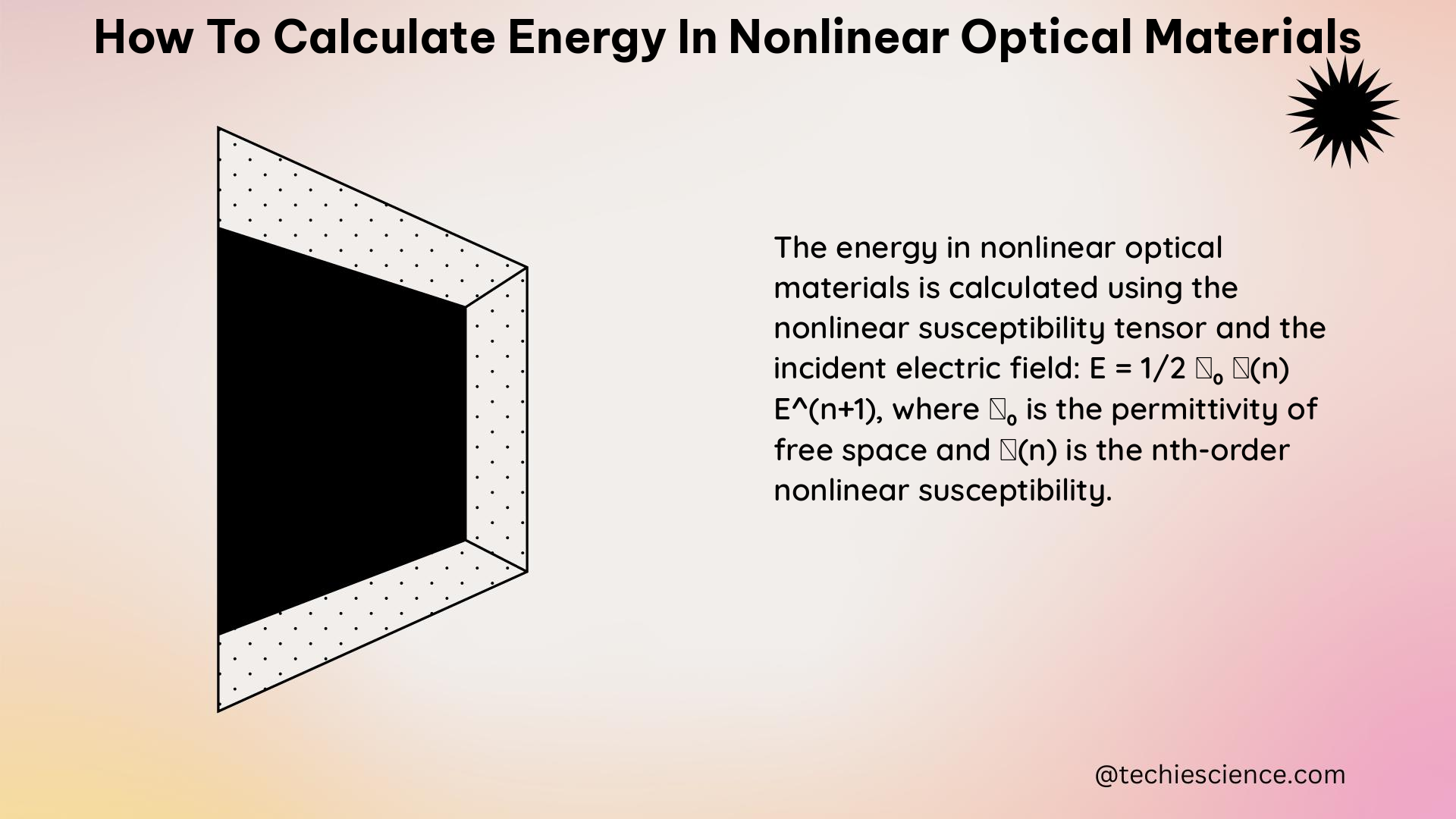Calculating the energy in nonlinear optical materials is a crucial step in understanding and optimizing their performance for various photonic applications. This comprehensive guide will provide you with the necessary tools and techniques to accurately determine the energy characteristics of these materials.
1. Absorption Coefficient Calculation
The absorption coefficient (α) is a fundamental parameter that describes the attenuation of light as it propagates through a material. To calculate the absorption coefficient, you can use the following formula:
α = -(1/d) * ln((T)/(1 - R))
Where:
– d is the thickness of the material
– T is the transmissivity of the material
– R is the reflectivity of the material
By measuring the transmissivity and refractive index of the material, you can determine the absorption coefficient using this equation.
2. Nonlinear Susceptibility Calculation

The nonlinear susceptibility (χ^(3)) is a crucial parameter that describes the nonlinear optical response of a material. You can calculate the nonlinear susceptibility using the Kramers-Kronig (K-K) relations, which relate the nonlinear absorption coefficient (α_2) and the nonlinear refractive index coefficient (n_2):
n_2(ω_a; ω_a) = (c/π) * ∫_0^∞ (α_2(ω'; ω_b) / (ω'^2 - ω_a^2)) dω'
Where:
– c is the speed of light
– ω_a and ω_b are the frequencies of the incident light
– α_2(ω'; ω_b) is the nonlinear absorption coefficient at frequency ω'
By measuring the nonlinear absorption coefficient and using the K-K relations, you can determine the nonlinear susceptibility of the material.
3. Nonlinear Refractive Index Calculation
The nonlinear refractive index (n_2) is another important parameter that describes the nonlinear optical response of a material. You can calculate the nonlinear refractive index using the following formula:
n_2 = (3 * χ^(3)) / (4 * ε_0 * c * n_0^2)
Where:
– ε_0 is the vacuum permittivity
– c is the speed of light
– n_0 is the linear refractive index of the material
By knowing the nonlinear susceptibility and the linear refractive index, you can determine the nonlinear refractive index of the material.
4. Two-Photon Absorption Calculation
Two-photon absorption is a nonlinear optical process that can occur in materials. You can calculate the two-photon absorption coefficient (β) using the following formula:
β = (3 * ω) / (2 * ε_0 * c * n_0^2) * Im[χ^(3)]
Where:
– ω is the frequency of the incident light
– ε_0 is the vacuum permittivity
– c is the speed of light
– n_0 is the linear refractive index of the material
– Im[χ^(3)] is the imaginary part of the nonlinear susceptibility
By measuring the nonlinear susceptibility and the linear refractive index, you can determine the two-photon absorption coefficient of the material.
5. MP2 Calculations
Another approach to studying the nonlinear optical properties of materials is to use second-order Møller-Plesset perturbation theory (MP2) calculations. These calculations can provide detailed information on the effect of π-conjugation on the electronic and nonlinear optical properties of materials, such as para-nitroaniline (pNA) derivatives.
6. Experimental Methods
In addition to theoretical calculations, experimental methods can also be used to determine the nonlinear optical properties of materials. Techniques such as measuring transmissivities and refractive indices can be employed to calculate the absorption coefficient of optical materials. Furthermore, phase code multiplexing in volume holography can be used to study the nonlinear optical properties of materials.
7. Theoretical Models
Various theoretical models can be used to understand and calculate the nonlinear optical properties of materials. These include the bound-electronic Kerr effect, Raman-induced Kerr effect, molecular orientational Kerr effect, two-photon absorption, and the ac Stark effect.
By combining these methods and techniques, you can accurately calculate the energy characteristics of nonlinear optical materials, enabling you to design and optimize photonic devices and systems for a wide range of applications.
References
- Calculation of the Absorption Coefficients of Optical Materials by Measuring the Transmissivities and Refractive Indices: https://www.researchgate.net/publication/251490023_Calculation_of_the_Absorption_Coefficients_of_Optical_Materials_by_Measuring_the_Transmissivities_and_Refractive_Indices
- IEEE Nonlinear Optics, Materials, Fundamentals, and Applications: https://apps.dtic.mil/sti/tr/pdf/ADA292438.pdf
- Methodology of Characterization of Nonlinear Crystals I: https://www.youtube.com/watch?v=9rHeBv7ot8Y
- MP2 Calculations of the Effect of the π-Conjugation on the Electronic and Nonlinear Optical Properties of Para-Nitroaniline (pNA) Derivatives: https://www.researchgate.net/publication/347581605_MP2_calculations_of_the_effect_of_the_p-conjugation_on_the_electronic_and_nonlinear_optical_properties_of_para-nitroaniline_pNA_derivatives
- Third Order Optical Nonlinearities: http://www.phys.unm.edu/msbahae/publications/OSA-Handbook%20of%20Optics-IV-Ch17.pdf

The lambdageeks.com Core SME Team is a group of experienced subject matter experts from diverse scientific and technical fields including Physics, Chemistry, Technology,Electronics & Electrical Engineering, Automotive, Mechanical Engineering. Our team collaborates to create high-quality, well-researched articles on a wide range of science and technology topics for the lambdageeks.com website.
All Our Senior SME are having more than 7 Years of experience in the respective fields . They are either Working Industry Professionals or assocaited With different Universities. Refer Our Authors Page to get to know About our Core SMEs.